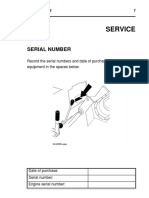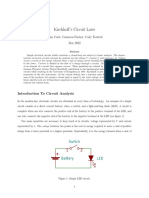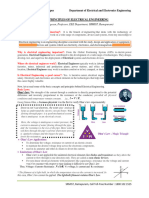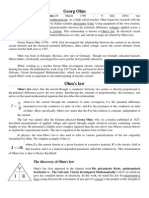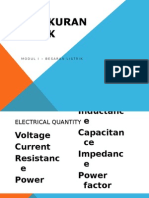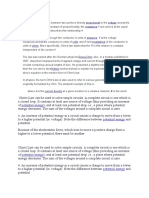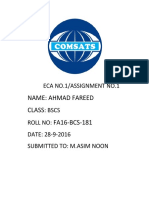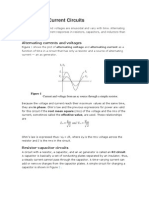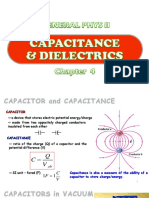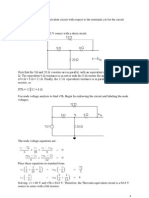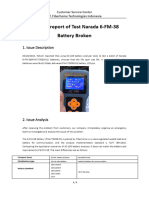0 ratings0% found this document useful (0 votes)
3 viewsPRELIM NOTES
PRELIM NOTES
Uploaded by
Marivon Hilado CagayananCopyright:
© All Rights Reserved
Available Formats
Download as DOCX, PDF, TXT or read online from Scribd
PRELIM NOTES
PRELIM NOTES
Uploaded by
Marivon Hilado Cagayanan0 ratings0% found this document useful (0 votes)
3 views1 pageCopyright
© © All Rights Reserved
Available Formats
DOCX, PDF, TXT or read online from Scribd
Share this document
Did you find this document useful?
Is this content inappropriate?
Copyright:
© All Rights Reserved
Available Formats
Download as DOCX, PDF, TXT or read online from Scribd
Download as docx, pdf, or txt
0 ratings0% found this document useful (0 votes)
3 views1 pagePRELIM NOTES
PRELIM NOTES
Uploaded by
Marivon Hilado CagayananCopyright:
© All Rights Reserved
Available Formats
Download as DOCX, PDF, TXT or read online from Scribd
Download as docx, pdf, or txt
You are on page 1of 1
Direct current:
1. The unidirectional flow of an electric charge is
referred to as direct current. Current flows in
one direction only
2. Direct current can flow through conductors like
wires, but it can also flow through
semiconductors and even a vacuum.
3. Electric current differs from alternating current
in that it flows in a constant direction.
4. Some examples of DC current are the mobile
battery providing DC power, the laptop battery
providing DC power, solar panels generating
direct current (DC), and Power banks providing
Analyzing rows 1, 2 and 3, we come to understand that
DC power.
doubling and tripling the voltage leads to doubling and a
An alternating current can be defined as a current that
tripling of the current in the circuit. Likewise, when we
changes its magnitude and polarity at regular intervals
compare rows 1 and 4 and rows 2 and 5, we come to
of time. It can also be defined as an electrical current
understand that doubling the total resistance serves to
that repeatedly changes or reverses its direction
halve the current in the circuit.
opposite to that of Direct Current or DC, which always
Kirchhoff’s Current Law (KCL)
flows in a single direction
Kirchhoff’s Current Law, often shortened to KCL, states
AC is the form of current that is mostly used in different
that “The algebraic sum of all currents entering and
appliances. Some of the examples of alternating current
exiting a node must equal zero.”
include audio signal, radio signal, etc. An alternating
Kirchhoff’s Voltage Law (KVL)
current has a wide advantage over DC as AC is able to
The principle known as Kirchhoff’s Voltage
transmit power over large distances without great loss
Law (discovered in 1847 by Gustav R. Kirchhoff, a
of energy.
German physicist) can be stated as such:
OHM’S LAW
“The algebraic sum of all voltages in a loop must equal
Ohm’s law states the relationship between electric
zero”
current and potential difference. The current that flows
By algebraic, I mean accounting for signs (polarities) as
through most conductors is directly proportional to the
well as magnitudes. By loop, I mean any path traced
voltage applied to it. Georg Simon Ohm, a German
from one point in a circuit around to other points in that
physicist was the first to verify Ohm’s law
circuit, and finally back to the initial point.
experimentally.
V = IR
Ohm’s law only holds true if the provided temperature
and the other physical factors remain constant. In
certain components, increasing the current raises
the temperature. An example of this is the filament of a
light bulb, in which the temperature rises as the current
is increased. In this case, Ohm’s law cannot be
applied. The lightbulb filament violates Ohm’s Law.
Ohm’s Law Statement: Ohm’s law states that the
voltage across a conductor is directly proportional to the
current flowing through it, provided all physical
conditions and temperature, remain constant.
Ohm’s Law Equation: V = IR, where V is the voltage
across the conductor, I is the current flowing through
the conductor and R is the resistance provided by the
conductor to the flow of current.
You might also like
- 255 Vibratory Plow Operator's Manual 4Document73 pages255 Vibratory Plow Operator's Manual 4Dennis PedrozaNo ratings yet
- Generator Sets - Electrical Fundamentals - LEHQ3210 - Apr 1993 - CATERPILLARDocument44 pagesGenerator Sets - Electrical Fundamentals - LEHQ3210 - Apr 1993 - CATERPILLARpevareNo ratings yet
- Electric Circuit Research PaperDocument4 pagesElectric Circuit Research PaperXChoGodxNo ratings yet
- Key Difference - OhmDocument4 pagesKey Difference - OhmEEE UCETKYNo ratings yet
- EE110_Chapter 1_ notesDocument53 pagesEE110_Chapter 1_ notes1ayusharun1No ratings yet
- UntitledDocument4 pagesUntitledJanet ChenNo ratings yet
- Unit-1 2Document20 pagesUnit-1 2Akhilesh Kumar MishraNo ratings yet
- Kirchhoff S Circuit LawsDocument13 pagesKirchhoff S Circuit Lawsapi-644343097No ratings yet
- UNIT I NotesDocument34 pagesUNIT I NotesKarthikeyan VNo ratings yet
- A Historical Overview of Basic Electrical Concepts For Field Measurement TechniciansDocument3 pagesA Historical Overview of Basic Electrical Concepts For Field Measurement TechniciansManuel Philip ZamoraNo ratings yet
- Basic Principles of Electrical EngineeringDocument4 pagesBasic Principles of Electrical EngineeringGunjit KartikeyNo ratings yet
- Lecture 02 Resistance and Resistors FullDocument9 pagesLecture 02 Resistance and Resistors FullKandi PrintNo ratings yet
- PHYSICS ElectrostaticsDocument13 pagesPHYSICS ElectrostaticsHarsha VarthanNo ratings yet
- Basic Concept of Electrical CircuitsDocument1 pageBasic Concept of Electrical Circuitsmminions342No ratings yet
- My Hand BookDocument11 pagesMy Hand BookVasanthKumarNo ratings yet
- Current Electricity PDF (16-19)Document18 pagesCurrent Electricity PDF (16-19)Abhay MauryaNo ratings yet
- The Practical Benefits in Ohms Law Is Determining The Barriers Can Replacement of Each Circuit, Radios Ad TVDocument2 pagesThe Practical Benefits in Ohms Law Is Determining The Barriers Can Replacement of Each Circuit, Radios Ad TVJuju ManullangNo ratings yet
- WWW Electrical4u ComDocument5 pagesWWW Electrical4u ComNh Chuminda YapaNo ratings yet
- UNIT 2.docxDocument11 pagesUNIT 2.docxabhimanyukr00003No ratings yet
- First Home WorkDocument3 pagesFirst Home WorkSifa RahmaniaNo ratings yet
- Basic Electrical Engineering NotesDocument45 pagesBasic Electrical Engineering NotesmnmnNo ratings yet
- Kirchoff Law - TKLDocument9 pagesKirchoff Law - TKLFaris RiyadiNo ratings yet
- 1.1. BackgroundDocument2 pages1.1. BackgroundJuju ManullangNo ratings yet
- Ohm's LawDocument11 pagesOhm's LawMarifer RamirezNo ratings yet
- DC CircuitsDocument26 pagesDC CircuitsMary Jean ParagsaNo ratings yet
- ECE131 Unit 1 Lecture 2Document35 pagesECE131 Unit 1 Lecture 2Vijay ReddyNo ratings yet
- Chapter 1 Basic ElectricityDocument26 pagesChapter 1 Basic ElectricityBirhex FeyeNo ratings yet
- LiteratureDocument2 pagesLiteratureJuju ManullangNo ratings yet
- Practice "Electric Impedance".: 183110679@upmh - Edu.mx 183111294@upmh - Edu.mx 183110087@upmh - Edu.mxDocument4 pagesPractice "Electric Impedance".: 183110679@upmh - Edu.mx 183111294@upmh - Edu.mx 183110087@upmh - Edu.mxRAFAEL LEGORRETA CASTA�EDANo ratings yet
- 276 - BE8251 Basic Electrical and Electronics Engineering - UNIT I ELECTRICAL CIRCUITS and MEASUREMENTS NotesDocument42 pages276 - BE8251 Basic Electrical and Electronics Engineering - UNIT I ELECTRICAL CIRCUITS and MEASUREMENTS NotesBalaNo ratings yet
- Ilovepdf MergedDocument221 pagesIlovepdf Mergedharini31012007No ratings yet
- Modul 1-Besaran ListrikDocument32 pagesModul 1-Besaran ListrikYusup SuryadiNo ratings yet
- Practical EDDocument23 pagesPractical EDSuvigayaNo ratings yet
- Kirchhoff's LawDocument39 pagesKirchhoff's LawMariah Jeanne De VeraNo ratings yet
- FB DC2Document14 pagesFB DC2neelove423No ratings yet
- Electric Charge Electrons Conductor Wire Ions Electrolyte Plasma SI Ampere Coulomb AmmeterDocument2 pagesElectric Charge Electrons Conductor Wire Ions Electrolyte Plasma SI Ampere Coulomb AmmeterAzrul SyazwanNo ratings yet
- Electric 1stDocument35 pagesElectric 1stMohammed ElmadaniNo ratings yet
- Jose RizalDocument11 pagesJose RizalBaet RayanNo ratings yet
- Current Electricity. MiaDocument42 pagesCurrent Electricity. MiaVerla MfeerNo ratings yet
- ElectricalDocument26 pagesElectrical3re0oooNo ratings yet
- Basic Electrical PDFDocument120 pagesBasic Electrical PDFapi-3730041100% (11)
- P6 ReviewerDocument14 pagesP6 ReviewerJohn Kenneth TandocNo ratings yet
- 1 - ELECTRICITYhandouts4Document5 pages1 - ELECTRICITYhandouts4JB TuganoNo ratings yet
- Ohm LawDocument5 pagesOhm LawRelax_pianoNo ratings yet
- Phy Assinment 2Document5 pagesPhy Assinment 2umarirfan208No ratings yet
- Potential Energy: Current Conductor Proportional Voltage ResistanceDocument2 pagesPotential Energy: Current Conductor Proportional Voltage Resistanceschauhan12No ratings yet
- Name: Renzo Jan H. Amorado Date: August 30, 2022 Course-Year-Section: BSME-2-EDocument6 pagesName: Renzo Jan H. Amorado Date: August 30, 2022 Course-Year-Section: BSME-2-ELev ShouyoNo ratings yet
- Ee00 PPPDocument203 pagesEe00 PPPlunalight253No ratings yet
- UNIT I Electrical Circuits:: BE8253 Basic Electrical, Electronics and InstrumentationDocument16 pagesUNIT I Electrical Circuits:: BE8253 Basic Electrical, Electronics and InstrumentationBalu ChanderNo ratings yet
- CH - 1-Electrical Engineering FundamentalsDocument43 pagesCH - 1-Electrical Engineering Fundamentalsrathina4careerNo ratings yet
- Name: Ahmad Fareed Class FA16-BCS-181: Eca No.1/Assignment No.1Document12 pagesName: Ahmad Fareed Class FA16-BCS-181: Eca No.1/Assignment No.1Waleed RazaNo ratings yet
- When Beginning To Explore The World of Electricity and ElectronicsDocument5 pagesWhen Beginning To Explore The World of Electricity and Electronics21037 Muhammad Abduh Akram AgusNo ratings yet
- PHYS101L LabReport9Document13 pagesPHYS101L LabReport9Leidee Charmellie SerranoNo ratings yet
- t7 ElglossDocument9 pagest7 ElglossianNo ratings yet
- Circuit Lab Report 1Document12 pagesCircuit Lab Report 1Melly FulaNo ratings yet
- Unit-III (Fundamentals of Electrical Engg.) PDFDocument32 pagesUnit-III (Fundamentals of Electrical Engg.) PDFpramana_gmritNo ratings yet
- Chapter Three DC and AC CircuitsDocument19 pagesChapter Three DC and AC CircuitsShaker HusienNo ratings yet
- CH - 1-Electrical Engineering FundamentalsDocument43 pagesCH - 1-Electrical Engineering Fundamentalsrathina4careerNo ratings yet
- Ohm'S Law: Name: Chura Cachi Jose Manuel Semester: Second Career: Industrial Electricity Matter: EnglishDocument9 pagesOhm'S Law: Name: Chura Cachi Jose Manuel Semester: Second Career: Industrial Electricity Matter: EnglishJorel LopezNo ratings yet
- Alternating Current CircuitsDocument34 pagesAlternating Current CircuitsLeah Mae LaguitNo ratings yet
- His Article Is About The Law Related To ElectricityDocument22 pagesHis Article Is About The Law Related To ElectricitySandeep GuptaNo ratings yet
- Complete Electronics Self-Teaching Guide with ProjectsFrom EverandComplete Electronics Self-Teaching Guide with ProjectsRating: 3 out of 5 stars3/5 (2)
- Códigos de Falla ABSDocument8 pagesCódigos de Falla ABSAlvaro Escalona GtzNo ratings yet
- Setra Systems: DPT 264 Series Low Pressure Transducers and Transmitters Installation GuideDocument4 pagesSetra Systems: DPT 264 Series Low Pressure Transducers and Transmitters Installation Guidesuperpuma86No ratings yet
- Chapter 4 Capacitance PDFDocument12 pagesChapter 4 Capacitance PDFRessyl Mae PantiloNo ratings yet
- Electronic Concepts First EditionDocument34 pagesElectronic Concepts First EditionAnkit100% (9)
- PDFDocument29 pagesPDFWenzy BorromeoNo ratings yet
- Word Bank StudentDocument2 pagesWord Bank Studentapi-456235166No ratings yet
- Sensata How To Design Precharge Circuits Evs WhitepaperDocument13 pagesSensata How To Design Precharge Circuits Evs WhitepaperqmnwebNo ratings yet
- Instrumentation AptitudeDocument77 pagesInstrumentation AptitudePrasath KumarNo ratings yet
- Micro LaterologDocument25 pagesMicro Laterologali_hamza223No ratings yet
- Quality Control Thesis PDFDocument8 pagesQuality Control Thesis PDFnicolejonesseattle100% (2)
- CH 4Document6 pagesCH 4Shaker Ullah ChowdhuryNo ratings yet
- Fluke 10 11 12 Service PDFDocument45 pagesFluke 10 11 12 Service PDFLODELBARRIO RDNo ratings yet
- EPO630 - Chapter 4b - Measurements of HV and CurrentsDocument28 pagesEPO630 - Chapter 4b - Measurements of HV and CurrentsfajrinaNo ratings yet
- Analysis Report of Test Narada 6-FM-38 Battery BrokenDocument3 pagesAnalysis Report of Test Narada 6-FM-38 Battery Brokenrohidi.fiberhomeNo ratings yet
- Baumer Undk 30 Series Catalog Pages 02 11 15 2480Document4 pagesBaumer Undk 30 Series Catalog Pages 02 11 15 2480black02aNo ratings yet
- Chiller 19XR PDFDocument72 pagesChiller 19XR PDFDaniNo ratings yet
- Sharp LC-19LE430EDocument205 pagesSharp LC-19LE430EStarburstNo ratings yet
- Manual Do Relé MRN-3-1Document40 pagesManual Do Relé MRN-3-1DISJUNTORNo ratings yet
- Hardware Intelligent Decentralized Automation System: Advant Controller 31Document50 pagesHardware Intelligent Decentralized Automation System: Advant Controller 31alaouiNo ratings yet
- Loss of Charge MethodDocument2 pagesLoss of Charge MethodnpavankNo ratings yet
- Power Quality Improvement in IEEE-39 RTS System by Using DATATCOM Mitigation of Voltage Sag AnalyticallyDocument6 pagesPower Quality Improvement in IEEE-39 RTS System by Using DATATCOM Mitigation of Voltage Sag AnalyticallyJAGANNATH PATRANo ratings yet
- Electric Current and Circuits: OutlineDocument82 pagesElectric Current and Circuits: Outlineaaa bbbNo ratings yet
- B727 System DescriptionsDocument78 pagesB727 System DescriptionsÓscar David Henao Merchán100% (1)
- HTTP WWW - Dgserve HPSV FittDocument18 pagesHTTP WWW - Dgserve HPSV FittSuresh SulebhaviNo ratings yet
- 17.8 Omron MM4XPDocument2 pages17.8 Omron MM4XPjayabalNo ratings yet
- Surface Mount Ceramic CapacitorsDocument24 pagesSurface Mount Ceramic CapacitorsKrzysztof BondkaNo ratings yet
- LCA LAB REPORT 8 IncompleteDocument12 pagesLCA LAB REPORT 8 IncompleteHamid RajpootNo ratings yet
- Communication ErrorDocument24 pagesCommunication Errorali wardana100% (4)
